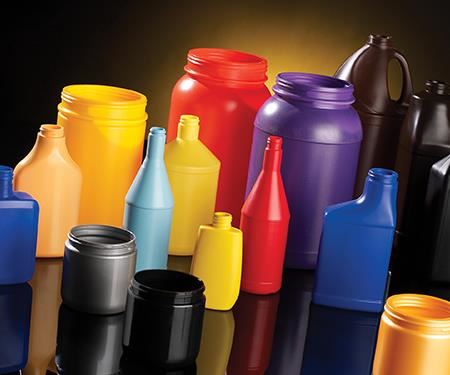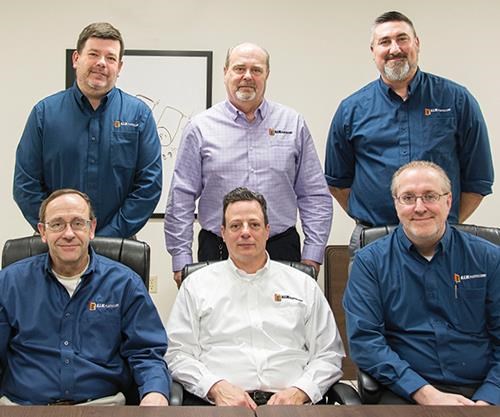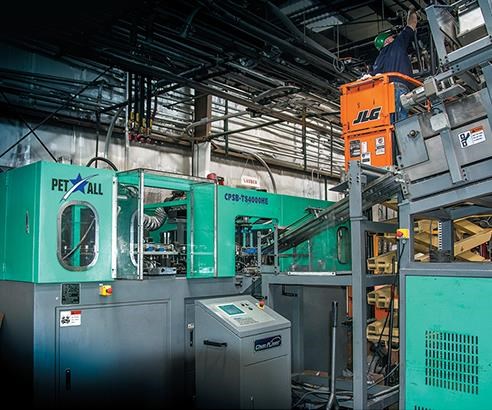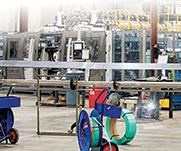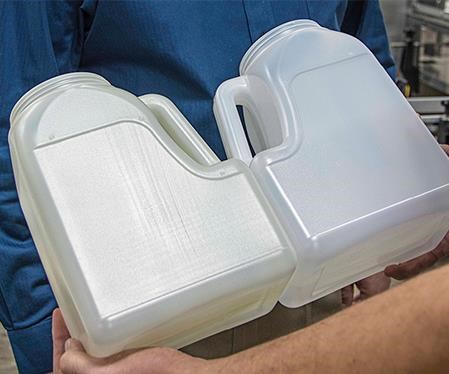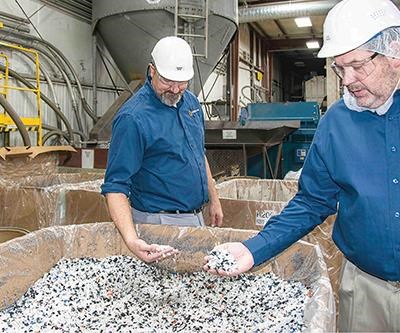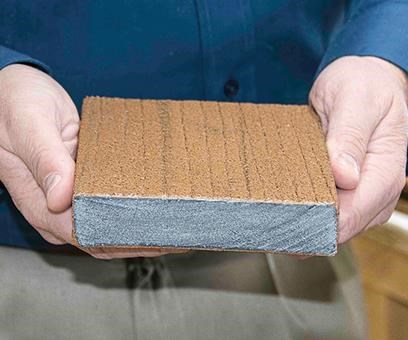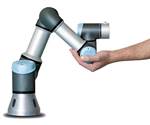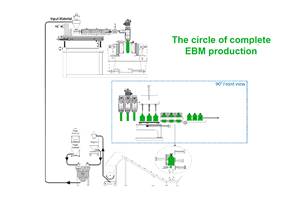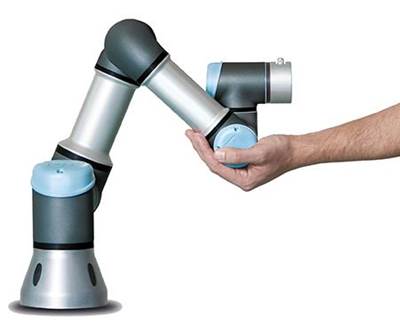Ahead of the Curve in Recycling
On-Site
A pioneer in recycling milk bottles built a thriving business in plastic lumber, but blow molding with PCR has proved a longer, harder road to success.
It started with a dare. After a round of golf, Irvin Vincent was having a drink with a manufacturer of liquid soap. Vincent, a one-time Wisconsin farm boy who became a cost accountant for one of the state’s lumber companies, knew nothing about plastics. But the soap maker offered him a challenge: “If you can make me a plastic bottle for my soap, I’ll buy it.”
Vincent was a man who liked challenges, and in short order he set up a 5000 ft2 shop next door to the soap maker in Luxemburg, Wis., to blow bottles. But he soon found out that in two weeks he could make all the bottles his neighbor would need for a year, and realized he’d better round up some more customers.
That was 1968. Today, N.E.W. Plastics Corp. has 200 employees and operates out of two buildings totaling 110,000 ft2 (including the former space of the soap maker), plus a warehouse of 100,000 ft2. The firm—now owned by Vincent’s two sons, who are both company executives (Irvin died in 2003)—will have revenues over $50 million this year from three distinct business units—blow molding; plastic lumber; and a distributor (VBS Total Packaging LLC) of packaging supplies (closures, tubes, pouches, etc.) and services like screen printing and labeling. The distribution business is based in Lombard, Ill., and has four employees. Manufacturing revenue accounts for $39 million of the total, about two-thirds of which comes from blow molding and one-third from plastic lumber.
THE SECOND CHALLENGE: RECYCLING
In the spring of 1973, N.E.W. (for Northeast Wisconsin) Plastics bought its first milk-bottle machine. About that time, plastics were drawing adverse attention from the nascent environmental movement. The neighboring state of Minnesota was already talking about banning plastics from landfills. Vincent wondered, why not make something—pallets, perhaps—from used bottles?
N.E.W.’s main supplier of HDPE back then was Gulf Oil’s plastics division, so Vincent asked a Gulf representative who was visiting the plant what he thought about that idea. As told by Lynie Vincent, co-owner of N.E.W. with his brother Vern, the Gulf man asked Irvin Vincent for a phone book. He started thumbing through the yellow pages and asked if there was a good hospital in the vicinity. Vincent assured him there was one. The visitor then asked, “Does it have a psych ward?” Vincent said he assumed that it did. The visitor replied, “Then you better check yourself in, because you’d be nuts to try recycling post-consumer plastics. It can’t be done.”
“My father was the kind of person who always asked, ‘Why can’t we do it?’ So we machined a die and attached it to the extruder head of the milk-bottle machine, and then extruded a profile from post-consumer milk bottles.” As Lynie tells it, his father and a colleague drove all the way to Gulf’s headquarters in Houston. “They dropped a piece of the PCR profile on the representative’s desk, and then drove back to Wisconsin.”
By the fall of that year, N.E.W. produced what is claimed to be the industry’s first recycled plastic lumber. After three more years of refinement, the product was ready for market. Structures built with this product in 1976 are “still going strong and looking good,” says Lynie Vincent. The plastic lumber operation, which occupies the smaller of the two buildings in Luxemburg, was established as a separate business unit, RENEW Plastics, in 1986.
What about PCR (post-consumer reclaim) in bottles? Blow molders like N.E.W. have always reused trim scrap and reject bottles. N.E.W. also took back contaminated or discontinued products from customers to use in its extruded lumber. By the early 1990s, customers started asking, “Can’t you use recycle in bottles?” That began what is now a quarter-century effort by N.E.W. to promote use of PCR in blow molding.
That effort still has a long way to go. Food packaging is 80% of N.E.W.’s blow molding business—the rest being chemical, agricultural, and industrial containers and occasional nonpackaging products. Food packagers so far have been hesitant to include PCR in their bottles. “We still have to worry about the chance that someone cut the top off an HDPE bottle to catch motor oil drained from his car,” says Vincent.
The exceptions are some makers of nutraceutical powders, an important market for N.E.W., which are interested in using 100% PCR in their packaging. “We made them bottles for trials, and they were pleased with the results,” Vincent reports. “Now we have to see if they will proceed with it.”
N.E.W. also makes industrial containers for Fortune 500 customers that use 25-50% PCR to meet California regulations. These containers are mostly for dry products.
A lot of customers ask about PCR, says Vincent. “Some even want 100% PCR, with a handle, which is very difficult to do.” But then they find out that using PCR will cost them more, not less. And they learn that inconsistent color is another issue they’d have to accept. Controlling color with PCR is one of our biggest problems.”
There are, of course, ways of dealing with off-color recycle. When a new lot of PCR comes in, N.E.W. tests it for melt flow rate (a capillary rheometer is on order for more sophisticated rheology testing) and molds a “dog bone” sample to check the color in a spectrophotometer. “We cherry-pick the best for use in bottles,” says Brandon Beard, quality and production leader. “The rest goes across the street to the lumber operation.”
“We have used granite color concentrates to cover up color variations,” adds Vincent. “But some customers don’t want to hide it. They want consumers to see they are using recycle in their packaging.”
Cost is another matter. Much to some people’s surprise, bottle-quality PCR costs more than prime virgin—especially at today’s low resin prices. And PCR’s inconsistencies lead to processing inefficiencies and reduced productivity. Notes Vincent, “PCR is more challenging to run. Its variability leads to problems with tail lengths, unmelts, and bottle weights going out of spec. So we have to slow production down. When a 13-sec cycle becomes 15-16 sec, that costs you real quick.”
Beard estimates that running PCR costs 4-5% in productivity when running cylindrical bottles and 8-10% for handleware. To make up for PCR variability, N.E.W. also may be forced to run a thicker wall. “If using PCR adds weight to a bottle, is it really ‘green'?” Vincent asks. “That’s why lumber is a better use of PCR, from an operating standpoint. We can run it really well in that process.”
To handle PCR, N.E.W. uses screen packs on its extrusion blow molders and puts magnets under the hoppers to catch tramp metal. At present, N.E.W. is using less than 1 million lb of PCR in bottles, a small fraction of the amount it uses in lumber. Around 10% of its industrial containers—and almost none of its food containers—now use PCR, but that amount is growing, according to Vincent. “Five years from now, we’ll be using more PCR in bottles,” he predicts. “The technology will improve, and so will the demand.”
NEW FOOD QUALITY CERTIFICATION
Because food containers are its core market, N.E.W. is making a push to achieve higher-level quality certification. Last fall, it became one of the few rigid packaging plants in the U.S. to achieve SQF Level 2 certification from the Safe Quality Food Institute (sqfi.com). This certification is said to give N.E.W. a strong advantage in fulfilling the 2011 Food Safety Modernization Act requirements of the FDA. “We had been using the quality standards of the American Institute of Baking (AIB), which is very common in the packaging industry,” explains Mike Rekitzke, N.E.W. president. “Then came the peanut-butter scare a few years ago, and something else was needed.” Rekitzke says SQF is recognized by the Global Food Safety Initiative GFSI), an organization created in 2000 by an international trade association, the Consumer Goods Forum, whose U.S. members include Walmart, Kroger, Walgreens, Wegmans, Coca-
Cola, PepsiCo, Kellogg, Colgate-Palmolive, Kimberley-Clark, Procter & Gamble, Campbell Soup, and Johnson & Johnson.
SQF Level 2 involved certifying N.E.W.’s processes, procedures, documentation, methods of failure analysis, handling of customer complaints, vendor management, and more. Preparing for certification was an 18-month process. Beard points out some of the physical changes that were made, such as replacing the ceiling of the old soap plant to eliminate places where dust and dirt could collect and filter down onto the shop below. Rodent traps and “bug lights” were added to monitor pest activity. An outside contractor checks the lights and their collector pans every two weeks and reports to Beard on how many dead insects were found and of what species—“day fliers versus night fliers,” Beard explains. “Data like that can tell you whether somebody is propping a door open to have a smoke.”
Employees wear hairnets throughout the plant. And to enter certain areas, they must wash their hands first to meet SQF standards. “It’s meant to avoid introducing trace amounts of peanut butter or other allergens,” Beard notes. At a customer’s request, one production line feeds food jars into a clean area for inspection and packing. It’s an enclosed room with positive air pressure to keep out dust.
EXPANDING IN SPACE & SCOPE
N.E.W.’s 86,000 ft2 blow molding plant houses 30 machines, almost all of them new or rebuilt in the last five years. N.E.W. operates 24/7 and typically runs 15 to 17 machines on any given day, with three or four job changes per day. Its equipment includes two Uniloy injection-blow molders and 26 extrusion blow machines, either reprocating-screw or continuous-extrusion shuttle types, both types from Uniloy and Bekum, plus two brand-new shuttles from Taiwan, sold here by Can Mold, div. of Pet All Manufacturing Inc. (U.S. office in Adrian, Mich.).
Last July, the plant expanded by 20,000 ft2 for a new room to house the two large shuttles from Can Mold. The new machines were just being set up last month, along with an automated palletizing cell. The spacious new manufacturing area has bays for two more large machines. “These are the future,” says Vincent proudly.
N.E.W.’s current blow molding business is 80% PE and 20% PP. But the firm is venturing into new territory—PET containers—driven by customer requests for short-run custom bottles. The firm recently installed two reheat stretch-blow molders from Pet All Mfg.
Another expansion, of 5000 ft2, is planned for this year to build a machine shop for mold maintenance.
N.E.W. is increasing its level of automation. It already uses one six-axis robot to palletize jars, and Beard is looking into purchasing one of the new so-called “collaborative” robots for packing containers—either a Baxter or Sawyer robot from Rethink Robotics. These can work safely alongside humans without guarding (see February’s cover story).
A related area of expertise for N.E.W. is shrink sleeving. ”We have a reputation for overcoming challenges in sleeving difficult shapes,” says Beard. N.E.W. uses “dry” heating with infrared lamps instead of steam heating. Although dry heating is trickier to master, it allows for more flexibility through placing the lamps to direct heat selectively.
N.E.W. offers custom design services with 3D modeling to give customers a “virtual reality” demonstration of what the product will look like from all angles and quickly show the effect of alternatives such as with or without embossed lettering. It has an in-house designer and an engineering team that asks key questions such as, “How is it filled? Dry or liquid?”
The company makes frequent use of stereolithography (SLA) prototypes, supplied by an outside service bureau, to get physical models to a customer quickly. N.E.W. can produce functional prototypes in four to eight weeks by cutting a unit cavity in aluminum and molding actual parts on a venerable single-head Impco shuttle machine. N.E.W. also uses that machine for very short orders—as few as 5000 parts a year.
These services are part of what Rekitzke considers the main strength of N.E.W. Plastics—“building strong partnerships with long-term customers. We try to know what’s next in their pipelines, whether in package design or in new materials, so we can be ahead of the game in helping them develop their next products.” These long-term customers are both Midwestern regional companies and regional plants of national or global brands.
LUMBER LINES HUMMING
In the neighboring 24,000 ft2 building, RENEW Plastics runs 10 lumber lines based on 4-in. single-screw extruders from PTi, NRM, and Johnson Plastics Machinery. N.E.W. designed the downstream equipment itself. For example, Beard notes that no sufficiently heavy-duty cutoff saws were available when the operation got started, so they had to build their own.
These lines run around 1200 lb/hr, using proprietary technology to run up to eight boards at a time—many more than the competition, according to Vincent.
N.E.W.’s lumber business, RENEW Plastics has three brands, Evolve lumber, which is 100% HDPE; Revolve engineered composite; and Trimax structural lumber. Trimax, which accounts for about 20% of RENEW’s lumber business, consists of HDPE and 30% chopped glass fiber. The resin content of these products is 65-75% wide-spec or off-spec resin, which is categorized in Federal government statistics as post-industrial scrap, according to Vincent. The rest is PCR pellets or flake plus N.E.W.’s own reground purgings. RENEW Plastics has capacity to reprocess 25 million lb/yr of PCR. “We’re at full capacity now,” says Vincent. “We hope to squeeze out a few million pounds more through improved efficiencies.”
Related Content
Foam-Core Multilayer Blow Molding: How It’s Done
Learn here how to take advantage of new lightweighting and recycle utilization opportunities in consumer packaging, thanks to a collaboration of leaders in microcellular foaming and multilayer head design.
Read MoreLatest Data on Bottled Water Shows Continued Strong Growth
Bottled water’s volume surpassed soft drinks for the first time in 2016 and has done so every year since.
Read MoreGet Color Changes Right In Extrusion Blow Molding
Follow these best practices to minimize loss of time, material and labor during color changes in molding containers from bottles to jerrycans. The authors explore what this means for each step of the process, from raw-material infeed to handling and reprocessing tails and trim.
Read MoreFor Extrusion and Injection-Blow Molders, Numerous Upgrades in Machines and Services
Uniloy is revising its machinery lines across the board and strengthening after-sales services in tooling maintenance, spare parts and tech service.
Read MoreRead Next
ROBOTS TO ‘COBOTS’: Next-Gen Automation in Plastics Processing
So-called ‘collaborative robots’ are a new category of ‘human-friendly’ automation that can work safely side by side with people, unprotected by guarding.
Read MoreLead the Conversation, Change the Conversation
Coverage of single-use plastics can be both misleading and demoralizing. Here are 10 tips for changing the perception of the plastics industry at your company and in your community.
Read MoreFor PLASTICS' CEO Seaholm, NPE to Shine Light on Sustainability Successes
With advocacy, communication and sustainability as three main pillars, Seaholm leads a trade association to NPE that ‘is more active today than we have ever been.’
Read More

